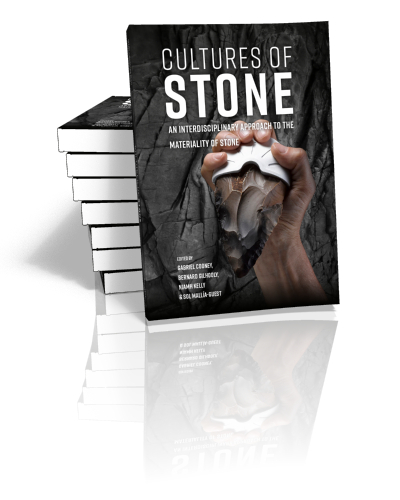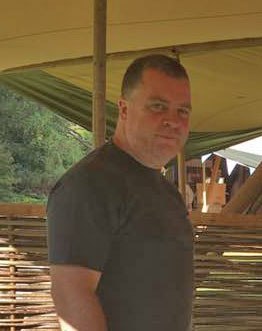Cultures of Stone
An Interdisciplinary Approach to the Materiality of Stone
Edited by Gabriel Cooney, Bernard Gilhooly, Niamh Kelly & Sol Mallía-Guest | 2020

Cultures of Stone
An Interdisciplinary Approach to the Materiality of Stone
Edited by Gabriel Cooney, Bernard Gilhooly, Niamh Kelly & Sol Mallía-Guest | 2020
Paperback ISBN: 9789088908910 | Hardback ISBN: 9789088908927 | Imprint: Sidestone Press | Format: 182x257mm | 298 pp. | Language: English | 60 illus. (bw) | 45 illus. (fc) | Keywords: materiality; stone; archaeology; tools; architecture; culture; ritual | download cover
Read online or downloaded 918 times
-
Digital & Online access
This is a full Open Access publication, click below to buy in print, browse, or download for free.
-
Buy via Sidestone (EU & UK)
-
Buy via our Distributors (WORLD)
For non-EU or UK destinations you can buy our books via our international distributors. Although prices may vary this will ensure speedy delivery and reduction in shipping costs or import tax. But you can also order with us directly via the module above.
UK international distributor
USA international distributor
-
Bookinfo
Paperback ISBN: 9789088908910 | Hardback ISBN: 9789088908927 | Imprint: Sidestone Press | Format: 182x257mm | 298 pp. | Language: English | 60 illus. (bw) | 45 illus. (fc) | Keywords: materiality; stone; archaeology; tools; architecture; culture; ritual | download cover
Read online or downloaded 918 times

We will plant a tree for each order containing a paperback or hardback book via OneTreePlanted.org.
This volume establishes a rich cross-disciplinary dialogue about the significance of stone in society across time and space. The material properties of stone have ensured its continuing importance; however, it is its materiality which has mediated the relations between the individual, society and stone.
Bound up with the physical properties of stone are ideas on identity, value, and understanding. Stone can act as a medium through which these concepts are expressed and is tied to ideas such as monumentality and remembrance; its enduring character creating a link through generations to both people and place.
This volume brings together a collection of seventeen papers which draw on a range of diverse disciplines and approaches; including archaeology, anthropology, classics, design and engineering, fine arts, geography, history, linguistics, philosophy, psychology and sciences.
List of Figures
Contributors
Acknowledgements
Introduction: Constructing Identities through Stone
Part 1. Quarrying and Moving Stone
Labour and Limestone: the relationship between stone and life in the 19th- and 20th-century quarry town of Texas, Maryland.
Adam Fracchia
Yapese Stone Money: local marble as a potential inspiration for producing limestone exchange valuables in Palau, Micronesia.
Bosiljka Glumac and Scott M. Fitzpatrick
Roman Colours of Power: Egyptian stones for the imperial metropolis, and beyond.
Hazel Dodge
Travelling Stone or Travelling Men? Models of Sculpture Production in the Early Middle Ages (8th–9th centuries).
Michelle Beghelli
Part 2. Making, Building and Re-imagining in Stone
MAN MADE: contemporary prehistoric stone-tool design.
Dov Ganchrow
Stone Fisheries and Their Role in Shaping the Cultural Landscape of the Minho River Valley, Portugal.
Rui Madail and Miguel Malheiro
Stormont’s Stones: the oratory of power through form and materiality.
Suzanne O´Neill
City of Stone: dialectics of impermanence in Josef Sudek’s Prague.
Adele Tutter
‘The Living Stones’: encountering the prehistoric past in West Cornwall.
Elizabeth Pratt
Sacred Granite: preserving the Downpatrick High Cross.
Michael King
Part 3. Stone in Ritual Space and Practice
‘Living Stones Built Up’: symbolism in Irish round towers.
Sarah Kerr
Flaming Torches: the materiality of fire and flames on Roman cinerary urns.
Liana Brent
Stone-Grave Building at the Cemetery of Les Tombes at Estagel (Pyrénées-Orientales, France): some economic, visual and symbolic aspects.
Joan Pinar Gil
Worship and Stones on the Cycladic Islands: a case study of the cult of Apollo and Zeus.
Erica Angliker
All of a Heap: Hermes and the stone cairn in Greek Antiquity.
Jessica Doyle
Looking through the Crystal Ball: ethnographic analogies for the ritual use of rock crystal.
Thomas Hess
Is It from The Dreaming, or Is It Rubbish? The Significance and Meaning of Stone Artefacts and Their Sources to Aboriginal People in the Pilbara region of Western Australia.
Edward McDonald and Bryn Coldrick
Afterword
The Flexibility of Stone
Gabriel Cooney
Index

Prof. Dr. Gabriel Cooney
Professor Gabriel Cooney is an Adjunct Professor in the School of Archaeology, University College Dublin. Gabriel’s area of specialisation is the Neolithic period and he has a particular interest in the use of stone by Neolithic people, from the artefact to the monumental scale. He is the director of the long running Irish Stone Axe Project which was the context for the discovery of a Neolithic axe quarry on Lambay, an island off the east coast of Ireland. His current focus of quarry studies is the North Roe Felsite Project in Shetland, investigating the character and the wider role of a major quarry complex during the Neolithic period in the Shetland archipelago.

Dr. Bernard Gilhooly
Bernard completed his BA, MA, and PhD in University College Dublin (UCD). His PhD focused on the manufacture and range of uses of Irish Mesolithic and Neolithic shale and porcellanite axes and adzes. This utilised a series of methodologies including quantitative and qualitative analysis, and the manufacture and use of experimental replicas. Bernard is an assistant keeper of antiquities in the National Museum of Ireland.

Niamh Kelly
Niamh Kelly is a PhD researcher with the School of Archaeology in University College Dublin. Her current research focuses on coarse stone tool technology from Ireland and the Irish Sea region, and the roles they play in defining task, self, culture and ritual. She has worked as a researcher and specialist on numerous projects across Ireland, Britain and wider Europe including the North Roe Felsite Project on the Shetland Islands, the Mesolithic in Mar Lodge in the Scottish uplands and Priniatikos Pyrgos in Crete. Niamh also has over ten years teaching experience at third level and is currently the Coordinator of a pre-university programme in Cultural and Heritage Studies based in the National Print Museum, Dublin.

Sol Mallía-Guest
Sol Mallía-Guest is a current PhD candidate at UCD School of Archaeology, exploring the role of flint artefacts in the Irish Neolithic from a comprehensive biographical approach, merging technological and use-wear analyses. Her current research builds on her MA work (UCD, 2011) that revealed the intricate life-paths of ‘everyday’ flint tools from Irish Early Neolithic rectangular timber houses.
Abstract:
This volume establishes a rich cross-disciplinary dialogue about the significance of stone in society across time and space. The material properties of stone have ensured its continuing importance; however, it is its materiality which has mediated the relations between the individual, society and stone.
Bound up with the physical properties of stone are ideas on identity, value, and understanding. Stone can act as a medium through which these concepts are expressed and is tied to ideas such as monumentality and remembrance; its enduring character creating a link through generations to both people and place.
This volume brings together a collection of seventeen papers which draw on a range of diverse disciplines and approaches; including archaeology, anthropology, classics, design and engineering, fine arts, geography, history, linguistics, philosophy, psychology and sciences.
Contents
List of Figures
Contributors
Acknowledgements
Introduction: Constructing Identities through Stone
Part 1. Quarrying and Moving Stone
Labour and Limestone: the relationship between stone and life in the 19th- and 20th-century quarry town of Texas, Maryland.
Adam Fracchia
Yapese Stone Money: local marble as a potential inspiration for producing limestone exchange valuables in Palau, Micronesia.
Bosiljka Glumac and Scott M. Fitzpatrick
Roman Colours of Power: Egyptian stones for the imperial metropolis, and beyond.
Hazel Dodge
Travelling Stone or Travelling Men? Models of Sculpture Production in the Early Middle Ages (8th–9th centuries).
Michelle Beghelli
Part 2. Making, Building and Re-imagining in Stone
MAN MADE: contemporary prehistoric stone-tool design.
Dov Ganchrow
Stone Fisheries and Their Role in Shaping the Cultural Landscape of the Minho River Valley, Portugal.
Rui Madail and Miguel Malheiro
Stormont’s Stones: the oratory of power through form and materiality.
Suzanne O´Neill
City of Stone: dialectics of impermanence in Josef Sudek’s Prague.
Adele Tutter
‘The Living Stones’: encountering the prehistoric past in West Cornwall.
Elizabeth Pratt
Sacred Granite: preserving the Downpatrick High Cross.
Michael King
Part 3. Stone in Ritual Space and Practice
‘Living Stones Built Up’: symbolism in Irish round towers.
Sarah Kerr
Flaming Torches: the materiality of fire and flames on Roman cinerary urns.
Liana Brent
Stone-Grave Building at the Cemetery of Les Tombes at Estagel (Pyrénées-Orientales, France): some economic, visual and symbolic aspects.
Joan Pinar Gil
Worship and Stones on the Cycladic Islands: a case study of the cult of Apollo and Zeus.
Erica Angliker
All of a Heap: Hermes and the stone cairn in Greek Antiquity.
Jessica Doyle
Looking through the Crystal Ball: ethnographic analogies for the ritual use of rock crystal.
Thomas Hess
Is It from The Dreaming, or Is It Rubbish? The Significance and Meaning of Stone Artefacts and Their Sources to Aboriginal People in the Pilbara region of Western Australia.
Edward McDonald and Bryn Coldrick
Afterword
The Flexibility of Stone
Gabriel Cooney
Index

Prof. Dr. Gabriel Cooney
Professor Gabriel Cooney is an Adjunct Professor in the School of Archaeology, University College Dublin. Gabriel’s area of specialisation is the Neolithic period and he has a particular interest in the use of stone by Neolithic people, from the artefact to the monumental scale. He is the director of the long running Irish Stone Axe Project which was the context for the discovery of a Neolithic axe quarry on Lambay, an island off the east coast of Ireland. His current focus of quarry studies is the North Roe Felsite Project in Shetland, investigating the character and the wider role of a major quarry complex during the Neolithic period in the Shetland archipelago.

Dr. Bernard Gilhooly
Bernard completed his BA, MA, and PhD in University College Dublin (UCD). His PhD focused on the manufacture and range of uses of Irish Mesolithic and Neolithic shale and porcellanite axes and adzes. This utilised a series of methodologies including quantitative and qualitative analysis, and the manufacture and use of experimental replicas. Bernard is an assistant keeper of antiquities in the National Museum of Ireland.

Niamh Kelly
Niamh Kelly is a PhD researcher with the School of Archaeology in University College Dublin. Her current research focuses on coarse stone tool technology from Ireland and the Irish Sea region, and the roles they play in defining task, self, culture and ritual. She has worked as a researcher and specialist on numerous projects across Ireland, Britain and wider Europe including the North Roe Felsite Project on the Shetland Islands, the Mesolithic in Mar Lodge in the Scottish uplands and Priniatikos Pyrgos in Crete. Niamh also has over ten years teaching experience at third level and is currently the Coordinator of a pre-university programme in Cultural and Heritage Studies based in the National Print Museum, Dublin.

Sol Mallía-Guest
Sol Mallía-Guest is a current PhD candidate at UCD School of Archaeology, exploring the role of flint artefacts in the Irish Neolithic from a comprehensive biographical approach, merging technological and use-wear analyses. Her current research builds on her MA work (UCD, 2011) that revealed the intricate life-paths of ‘everyday’ flint tools from Irish Early Neolithic rectangular timber houses.
-
Digital & Online access
This is a full Open Access publication, click below to buy in print, browse, or download for free.
-
Buy via Sidestone (EU & UK)
-
Buy via our Distributors (WORLD)
For non-EU or UK destinations you can buy our books via our international distributors. Although prices may vary this will ensure speedy delivery and reduction in shipping costs or import tax. But you can also order with us directly via the module above.
UK international distributor
USA international distributor
- Browse all books by subject
-
Search all books

We will plant a tree for each order containing a paperback or hardback book via OneTreePlanted.org.
You might also like:
© 2025 Sidestone Press KvK nr. 28114891 Privacy policy Sidestone Newsletter Terms and Conditions (Dutch)








